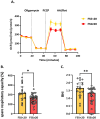Mitochondrial function in patients affected with fibromyalgia syndrome is impaired and correlates with disease severity
- PMID: 39632893
- PMCID: PMC11618515
- DOI: 10.1038/s41598-024-81298-x
Mitochondrial function in patients affected with fibromyalgia syndrome is impaired and correlates with disease severity
Abstract
Fibromyalgia is a musculoskeletal syndrome characterized by chronic widespread pain that is often associated with systemic manifestations. Since mitochondria are the main source of cellular energy, we hypothesized that fibromyalgia syndrome (FMS) could be linked to mitochondrial impairment. Aim was to study mitochondrial dysfunction in peripheral blood mononuclear cells isolated from 50 patients with primary FMS and 20 apparently healthy controls. Although no differences in mitochondrial basal respiration were observed between patients with primary FMS and healthy controls, a lower median bioenergetic health index (BHI; - 22.1%, p = 0.03), a proxy of mitochondrial function, was found in patients. According to fibromyalgia severity score (FSS), a composite of widespread pain index and symptom severity scale, a lower median BHI (- 18.7%) was found in patients with a FSS ≥ 20 compared to those with a FSS < 20. Negative moderate correlations were found only between BHI and FSS (r = - 0.36) and widespread pain index (r = - 0.38). We demonstrated that patients with FMS had an impaired mitochondrial function. Additionally, we found a mild correlation between the widespread pain index and the BHI, possibly indicating that the altered mitochondrial function, in these patients, narrows musculoskeletal rather than central nervous system involvement.
© 2024. The Author(s).
Conflict of interest statement
Declarations. Competing interests: The authors declare no competing interests.
Figures



References
-
- Clauw, D. J. Fibromyalgia: A clinical review. JAMA.311(15), 1547–1555 (2014). - PubMed
-
- Wolfe, F. et al. The American college of rheumatology 1990 criteria for the classification of fibromyalgia. Report of the multicenter criteria committee. Arthritis Rheum.33(2), 160–172 (1990). - PubMed
-
- Wolfe, F. et al. 2016 Revisions to the 2010/2011 fibromyalgia diagnostic criteria. Semin. Arthritis Rheum.46(3), 319–329 (2016). - PubMed
-
- McBeth, J. & Jones, K. Epidemiology of chronic musculoskeletal pain. Best Pract. Res. Clin. Rheumatol.21(3), 403–425 (2007). - PubMed
MeSH terms
Grants and funding
LinkOut - more resources
Full Text Sources
Medical
Miscellaneous

